

Photo taken on Nov 17, 2014 shows the heightened Danjiangkou Reservoir Dam. (Xinhua/ Hao Tong)
As the decades old plan to bring Yangtze River water 1,400 kilometers north to Beijing and neighboring areas nears completion, people living along the south-to-north water diversion project are reflecting on changes brought forth by the historic program.
CHANGE OF LIFE
When the project first started, Ye Mingcheng, a 58-year-old fish farmer from south China's Hubei Province, had mixed feelings about the Danjiangkou Dam.
His reluctance is understandable. The starting point of the south-to-north water diversion project, the Danjiangkou Dam began construction in 1958 following Chairman Mao's decision to divert water from the south to quench the dry north.
When the dam was completed in 1968, Ye's ancestral home in Junxian County was completely submerged in water and has remained that way ever since. A teenager at the time, he couldn't understand why his parents were crying as they moved to another county.
For financial and technical reasons, however, the south-to-north water diversion project didn't start following completion of the dam.
Five years later, Ye's family returned, settling down in a different section of Danjiangkou city and starting from scratch. Ye's father died in 1985. "He was happy to be buried in his hometown," said Ye.
With reform and opening-up, Ye's life improved. He built a big house, and earned nearly 200,000 yuan (about 33,000 U.S. dollars) a year from fish farming.
Bad news came in the 1990s. The south-to-north water diversion project had officially started. Ye was relocated again in 2009, away from his father's grave.
Now, he is wondering what to do with his net, cages and fish, which are worth 3.5 million yuan.
Ye is not the only one who made sacrifices for the project. To ensure the water quality, many of the residents surrounding the project had to find new careers, like 61-year-old Xin Xiyu.
Two years ago, Xin, a farmer in Danjiangkou city, gave Li Keqiang, then vice premier in China, a bottle of water from the reservoir during a reception in Beijing. As a representative of local people, she promised to let Beijingers drink clean water.
Xin's family lived near a barren hill. The woman couldn't remember how many times she cried for not being able to plant on the hill.
When she finally put forth a plan to plant walnut trees, she was told that fertilizer and pesticide would pollute the water, which would be supplied to Beijing.
"I then collected excrement of the livestock, put it into the bio-gas tank," she said. "The bio-gas fluid could replace pesticide, while the residue used as fertilizer."
Now she is promoting this technique among villagers. "To ensure the water quality is our common undertaking," she said.
Fan Zhihui, vice director of the environmental protection section of the Office of the South-to-North Water Diversion Project Commission (SNWDPC) of the State Council, noted that about 15 million people lived in the 95,000-square-kilometer area at the junction of Hubei, Henan and Shaanxi provinces, which was considered source of the water to Beijing.
Between 2009 and 2012, more than 340,000 people have moved away from their homes and more than 2,000 factories closed, said Zhang Jiyao, director of SNWDPC.
"Among the 43 counties in Hubei and Henan affected by the project, 34 are impoverished ones," he said.
The decision to move people away from their homes and livelihood's was often the most difficult to make, Zhang said.
To make up for Ye's loss, the local government gave him a two-story building after he moved out of his old residence. He also received compensation for the 120 net cages, with each worth of 1,000 to 1,800 yuan. He is now trying to sell his remaining 130,000 kilograms of fish.
Xin Xiyu was offered a compensation of about 250,000 yuan for her farm, and 100,000 yuan subsidy for building the bio-gas tanks.
Copyright ©1999-2018
Chinanews.com. All rights reserved.
Reproduction in whole or in part without permission is prohibited.